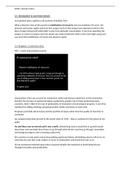Week 3 lecture notes:
3.1: Introduction to east Asian miracle
Very general point: applies to all countries including China
What underpins most of this growth is mobilisation of resources, the accumulation of K and L, the
physical and human capital and from that output much of that output was exported so there’s this
idea of export led growth which didn’t come from domestic consumption, it can from exporting the
output. In order to produce more for export you need investment which comes from high saving and
you need that mobilisation of human and physical capital.
3.3: Krugman, a contrarian view:
NICs = newly industrialised country
Summarised: Once you account for investment capital and human capital (K,L) in that production
function the increase of capital and labour explains the growth rate in these performing Asian
countries, there’s little in the way of productivity of innovation of technological progress, it can all be
explained by adding workings and giving workers better machinery to work with.
Krugman just thinks about inputs and the quantity of inputs rather than the quality of how they’re
combined
He compares East Asian growth to the Soviet Union in 1950 – there is evidence for this shown in his
paper
He said there was no miracle and it was a myth, diminishing returns would kick in, growth would
slow down and eventually they’d have to go through what all rich countries go through, innovation,
technological progress and increasing productivity.
All countries at some point cannot keep adding capital and labour, diminishing returns will set in, its
what they do next that really matters in terms of productivity and investment and so on.
SK has maintained relatively good rates of growth despite the headwind of diminishing returns
through innovation and productivity.
, Week 3 lecture notes:
Nobody can sustain 10% growth for 40 to 50 years, you would expect growth to decline and change
away from investment and towards more domestic consumption which we’ve seen in Singapore and
hong kong.
Krugman essential argues that growth that is not a result of productivity should not be counted as
economic growth proper – very controversial issue among economists some say of course growth
comes from applying capital and labour is and should be counted as growth, Krugman claims real
growth is just about productivity.
For many East Asian countries growth started from a low base – ‘Catch up’ stage,
underemployed labour and low stock of capital which means that once capital is starting to
get built and mobilising labour growth can be very quick that catch up growth to GDP and
output with richer countries is possible.
Largely to do with mobilisation of resources which Krugman identified.
There is a political and economic policy framework and an informal instutiutional framework
that allows that mobilisaiton of resource to happen and that should not be underestimated.
Largely export lead model of development, extra output exported and consumed by citizens
outside of your country.
Is the east Asian model for growth a template for other emerging economies?
There are some general views as to what you need for growth to happen but the context is different
for every country, so yes there are lessons to be learnt from other countries but applying the same
model is not appropriate.
3.4: Hong Kong
Hong Kong started growing after many Chinese crossed the border into Hong Kong, fleeing the
Chinese civil war. Britain handed back Hong Kong to China in 1997.
Why did Hong Kong have economic success?
Strategic location – 5 hours flying time from half the population
Political stability – (Until recently) Institutionally stable for investment
Excellent infrastructure – superb natural harbour, communication and transport links
Network in expertise in legal, financial and business service firms -over 60% of the worlds
top 500 business have a presence in Hong Kong
Laissez faire policy – little government intervention in the economy in terms of intervening in
markets, not to say there wasn’t any government intervention at all because there was
concerning housing and transportation etc
Very successful at attracting inward investment (for reasons above) – favourable place to do
business, low tax rate and stable environment within proximity to the worlds fastest growing
economy.
John Cowperthwaite – controlled the Hong Kong economy for 10 years (1961-1971) he was
for letting people and markets working themselves, he believed there was too much
emphasis on data and that people should ignore the data and be left to their own devices
and the market would grow by itself.
Hong Kong’s political future depends on China
3.5 South Korea:




